Luis Lanchero
| Luis Lanchero | |
|---|---|
| Born |
unknown Castile |
| Died |
1562 Tunja, New Kingdom of Granada |
| Nationality | Castilian |
| Other names | Luis Lancheros |
| Occupation | Conquistador |
| Years active | 1533-1559 |
| Employer | Spanish Crown |
| Known for |
Spanish conquest of the Muzo Foundation of Muzo, Boyacá |
| Religion | Catholic |
| Spouse(s) | unnamed |
| Children | 1 daughter |
Luis Lanchero, also known as Luis Lancheros (?, Castile - 1562, Tunja, New Kingdom of Granada) was a Spanish conquistador who is known as the founder of the town of Muzo, Boyacá, the most important emerald settlement of Colombia. This achievement came twenty years after many unsuccessful attempts to submit the Muzo to the Spanish rule. Lanchero arrived in the New World in 1533 and died impoverished in Tunja in 1562.
Biography

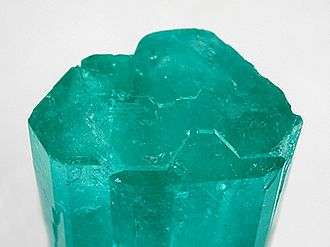
Luis Lanchero was born in Castile in a noble family. As a young man, he was employed in the guard of Spanish king Carlos V in which role he participated in the Sack of Rome in 1527.[1] In 1533, searching for adventure, Lanchero left Europe for what later would become Venezuela in a conquest expedition led by Jerónimo Ortal, also spelled as Hortal.[2] There, Luis Lanchero joined the expedition by Nikolaus Federmann towards the Colombian Andes, reaching the newly founded capital of the New Kingdom of Granada in 1538.[1] He became encomendero of Susa.[2]
When in 1539 Hernán Pérez de Quesada took over the governance of Bogotá from his elder brother and founder Gonzalo Jiménez de Quesada, he organised various expeditions in search of valuables and above all the quest for El Dorado. While not really satisfied with the presence of Luis Lanchero, he was sent towards the territories of the Muzo in western Boyacá in the first months of 1540.[3] The expedition into Muzo territories was difficult because of the terrain and to fight the lack of food, some horses were slaughtered.[4] After two unsuccessful attempts to submit the more than 10,000 bellicose Muzo, Lanchero marched through Panche territory in the south, the western portion of the current department of Cundinamarca back towards Bogotá.[3][4]
In early 1559, fifteen years after the discovery of the rich emerald deposits by Diego Martínez, Lanchero returned to Muzo terrain and passed through Maripí to found Villa de la Santísima Trinidad de los Muzos, today known as Muzo, on February 20, 1559.[5][6][7] On this expedition, Lanchero was accompanied by conquistador Pedro de Ursúa.[8] Muzo was first unsuccessfully founded as Tudela.[9] During the battles against the Muzo, Lanchero was hurt by an arrow in his chest.[8][10] In 1560, Lanchero handed the reign of Muzo over to the encomenderos, leading to successive battles over the rich emerald grounds.[11] On October 17, 1560, Lanchero also passed the control of Curipí to the encomienda.[12] After Miguel Diez de Armendariz took control of the area, Lanchero lost all his possessions.[12]
Luis Lanchero died in Tunja in 1562, leaving a wife and one daughter.[1]
Conquest by Luis Lanchero
| Name bold is founded |
Department | Date | Year | Notes | Map |
|---|---|---|---|---|---|
| Coper | Boyacá | 1540 | [13] | 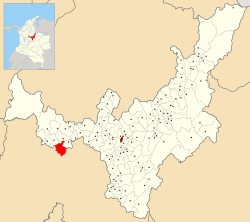 | |
| Pauna | Boyacá | 1540-41 | [14] | 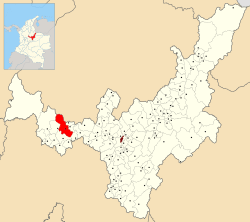 | |
| Quipama | Boyacá | 24 April | 1541 | [15] | 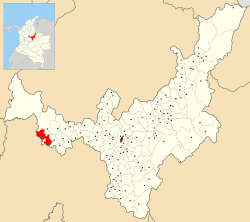 |
| Maripí | Boyacá | 1559 | [16] |  | |
| Muzo | Boyacá | 20 February | 1559 | [6][7] | 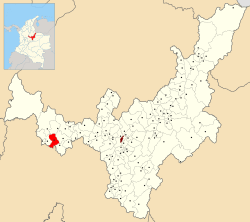 |
See also
 List of conquistadors in Colombia
List of conquistadors in Colombia Spanish conquest of the Muisca
Spanish conquest of the Muisca Muzo people, Hernán Pérez de Quesada
Muzo people, Hernán Pérez de Quesada Nikolaus Federmann
Nikolaus Federmann
References
- 1 2 3 (Spanish) Luis Lanchero - Banco de la República
- 1 2 Rodríguez Freyle, 1979 (1638), p.56
- 1 2 (Spanish) Description of the conquest of the Muzo
- 1 2 Tequia Porras, 2008, p.35
- ↑ Uribe, 1960, p.2
- 1 2 (Spanish) Official website Muzo
- 1 2 (Spanish) Muzo Patrimonio Histórico y Cultural para Colombia y el Mundo
- 1 2 Tequia Porras, 2008, p.37
- ↑ Puche Riart, 1996, p.100
- ↑ De Piedrahita, 1688, Chapter VI
- ↑ Tequia Porras, 2008, p.46
- 1 2 Tequia Porras, 2008, p.52
- ↑ (Spanish) Official website Coper
- ↑ (Spanish) Official website Pauna
- ↑ (Spanish) Official website Quipama
- ↑ (Spanish) Official website Maripí
Bibliography
- Fernández de Piedrahita, Lucas. 1688. VI.Historia general de las conquistas del Nuevo Reino de Granada. Accessed 2016-07-08.
- Puche Riart, Octavio. 1996. La explotación de las esmeraldas de Muzo (Nueva Granada), en sus primeros tiempos - The exploitation of the emeralds of Muzo (New Kingdom of Granada), the first period, 99-104. 3; Accessed 2016-07-08.
- Rodríguez Freyle, Juan, and Darío Achury Valenzuela. 1979 (1859) (1638). El Carnero - Conquista i descubrimiento del nuevo reino de Granada de las Indias Occidentales del mar oceano, i fundacion de la ciudad de Santa Fe de Bogota, 1-598. Fundacion Biblioteca Ayacuch. Accessed 2016-11-21.
- Tequia Porras, Humberto. 2008. Asentamiento español y conflictos encomenderos en Muzo desde 1560 a 1617 - Spanish settlement and encomienda conflicts in Muzo from 1560 to 1617 (M.A.), 1-91. Pontificia Universidad Javeriana. Accessed 2016-07-08.
- Uribe, Sylvano E.. 1960. Las esmeraldas de Colombia. Boletín de la Sociedad Geográfica de Colombia XVIII. 1-8. Accessed 2016-07-08.
Further reading
- Acosta, Joaquín. 1848. Compendio histórico del descubrimiento y colonización de la Nueva Granada en el siglo décimo sexto - Historical overview of discovery and colonization of New Granada in the sixteenth century, 1-460. Beau Press. Accessed 2016-07-08.